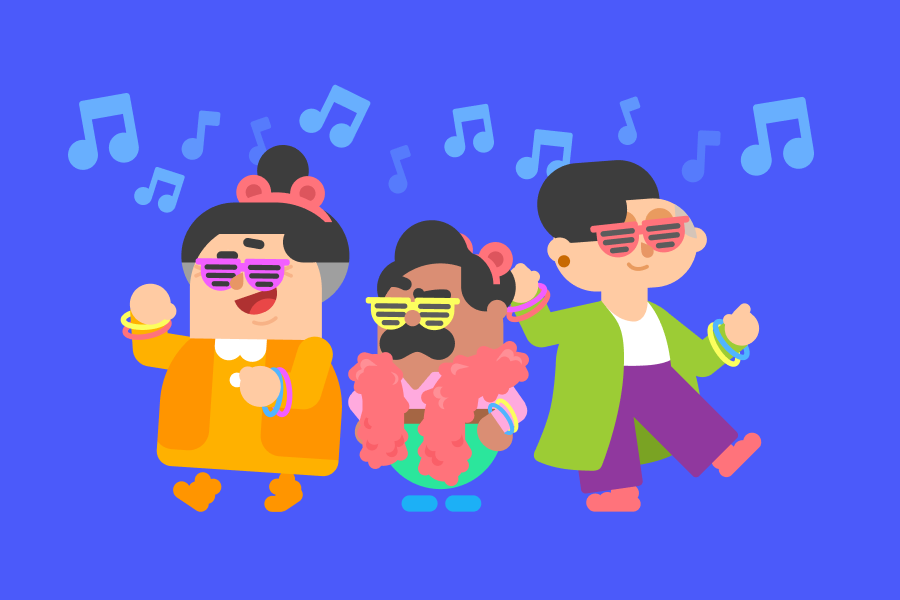In Brazil, we say that o ano só começa depois do Carnaval—the year only starts after Carnaval! The Carnival celebration (spelled Carnaval in Portuguese) marks the end of the Southern Hemisphere's summer break and the return to regular school and work schedules… but only after a 4-day nationwide party marathon.
Here are some of the traditions (and vocabulary) you'll find in Carnival celebrations around Brazil:
Esquenta: Brazil's Carnival pre-game
Before getting to the official celebrations and parades, many people have an esquenta: a pre-party gathering at a bar or someone's house to meet up and prepare for the event. This can include preparing your fantasias (more on that below), making drinks to take with you to the venue, or just getting into the party vibe with snacks and music! Sometimes, the esquenta is so good you never make it to the main attraction itself. 🙈
Common drinks you can find are cerveja (beer) and caipirinhas—one of Brazil's most famous exports. It's traditionally a mix of lemon, ice, sugar and cachaça, a distilled spirit made from sugar cane. Sometimes you'll find shots of flavored cachaças, like cachaça de jambu (a plant that gives the mouth a tingly sensation).
Fantasias: Carnival costumes
Carnival is a time to be as extravagant as you want: the bigger, the better! This is especially true for clothing, where the typical social rules are especially relaxed. You might dress a little more colorfully—like with a bright camiseta (T-shirt), breezy chinelos (flip flops) or just a pair of fun óculos (glasses)—or you can really impress with an imaginative fantasia (costume).
Fantasias can be of celebrities, memes (like the jam from Shakira's divorce drama), or all sorts of jokes—this group dressed as nuvem (cloud), but split it into nu (nude) and vem (come). You'll also find tiaras (headpieces), capas (capes), maquiagem (makeup or face paint), and loads of glitter (same as in English). Brazilians will find glitter in their clothes and hair long after Carnival is over!
Bloquinhos: Carnival parades
Bloquinho is literally a little bloco (street block), a general term for groups of people that form parades during Carnival. Brazilians use the -inho and -inha endings frequently, not just to express size, but also to convey affection, familiarity and uniqueness. Some bloquinhos can actually be very big and gather up to thousands of people!
These roaming parades fill the streets with song and dance courtesy of a trio elétrico: a truck equipped with huge speakers and a stage, where bands do their shows on the move. Sometimes they will be accompanied by a parade of people at street level doing choreography or even playing instruments.
Blocos often have specific themes: The Sargento Pimenta (Sargent Pepper) bloco plays Beatles songs in Carnival rhythms, the Fraldinha Molhada (Wet Little Diaper) bloco is for children, there's a Bollywood bloco hosted by the Indian community in São Paulo, and Galo da Madrugada (Dawn Rooster) is the biggest bloco in the world (and holds a Guinness World Record!).
Música: the sound of Carnival
Carnival brings together some of Brazilians' favorite musical genres:
- Marchinhas: the original soundtrack of Carnival! They evolved from military marches from Portugal and sometimes are played by marching bands.
- Axé: a cheerful genre meaning "positive energies" in the candomblé religion. It was born in Salvador, Bahia in the 80s and gained the country.
- Frevo: fast-paced music that started in Recife, Pernambuco. The name comes from ferver (to boil), since crowds dancing to frevo with tiny colorful umbrellas are like the jumping and bubbling of a boiling pot!
- Samba: music from Afro-Brazilian communities in Bahia and later popularized in Rio de Janeiro—and probably the music you most associate with Brazil! Afro-Brazilians organized escolas de samba (samba schools) where they could play samba in secret, to protect themselves from institutional violence. Today, escolas de samba have huge competitions for the best samba song and performance every year.
You'll also find parties in musical styles that are less carnaval-esque, like pop, electronic, Brazilian funk, and punk.
To listen to all these styles and more, check out our Spotify playlist for Portuguese learners!
And, finally: the Carnival ressaca (hangover)
Carnival is officially celebrated from Saturday through Tuesday, just before Ash Wednesday in the Christian calendar. None of these days are official *holidays*, but it is a tradition for Brazilians to have Tuesday and Wednesday morning off work.
That measure is not only convenient, but many times necessary, since foliões (the Carnival revelers) often endure intense ressacas (hangovers), exhaustion, and sometimes a ressaca moral—the emotional discomfort and regret from 4 days of Carnival decisions.
Ash Wednesday is the perfect time to make a very strong cafezinho (the diminutive of "coffee") and take a deep breath: Now we have to start the year.
Aproveite o Carnaval!
Enjoy Carnival!
Whether you're looking for a chance to practice your Portuguese, the opportunity to dance the day away, or an excuse for an extravagant costume, Brazilian Carnaval has something for you!



